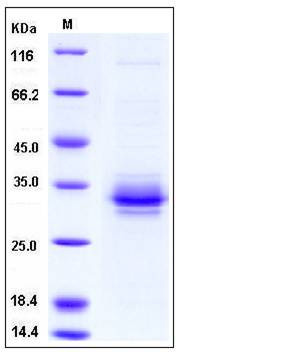Human FOLR2 / FBP Protein (His Tag)
BETA-HFR,FBP,FBP/PL-1,FR-BETA,FR-P3
- 100ug (NPP2134) Please inquiry
| Catalog Number | P11219-H08H |
|---|---|
| Organism Species | Human |
| Host | Human Cells |
| Synonyms | BETA-HFR,FBP,FBP/PL-1,FR-BETA,FR-P3 |
| Molecular Weight | The recombinant human FOLR2 consists of 223 amino acids and predictes a molecular mass of 26 kDa. In SDS-PAGE under reducing conditions, the apparent molecular mass of rh FOLR2 is approximately 30-35 kDa due to glycosylation. |
| predicted N | Thr 17 |
| SDS-PAGE |  |
| Purity | > 87 % as determined by SDS-PAGE |
| Protein Construction | A DNA sequence encoding the human FOLR2 (P14207-1) without the propeptide (Met 1-His 228) was fused with a polyhistidine tag at the C-terminus. |
| Bio-activity | |
| Research Area | Signaling |Signal Transduction |Metabolism |Pathways and Processes |Vitamins / minerals |
| Formulation | Lyophilized from sterile PBS, pH 7.4 1. Normally 5 % - 8 % trehalose, mannitol and 0.01% Tween80 are added as protectants before lyophilization. Specific concentrations are included in the hardcopy of COA. |
| Background | Folate receptor beta, also known as Folate receptor 2, FBP, and FOLR2, is a member of the folate receptor family. FOLR2 is expressed in placenta and hematopoietic cells. The expression of FOLR2 is increased in malignant tissues. Members of the Folate receptor family members (FOLRs) have a high affinity for folic acid and for several reduced folic acid derivatives. They mediate the delivery of 5-methyltetrahydrofolate to the interior of, out of within, or between cells in a process known as potocytosis. FOLR2 has a 68% and 79% sequence homology with the FOLR1 and FOLR3 proteins, respectively. The FOLR2 protein was originally thought to exist only in placenta, but is also detected in spleen, bone marrow, and thymus. FOLR2 is a marker for macrophages generated in the presence of M-CSF, but not GM-CSF. Its expression correlates with increased folate uptake ability. Folate conjugates of therapeutic drugs are a potential immunotherapy tool to target tumor-associated macrophages. |
| Reference |
